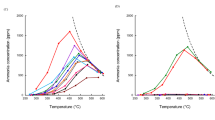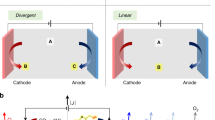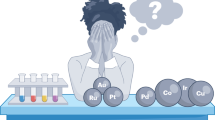Abstract
The costs and environmental impacts of catalyst manufacture are often neglected during early-stage research because of a lack of accessible, standardized tools to assess them. Here we report the key features of CatCost, a free and public estimation tool for the evaluation of catalyst cost. We demonstrate its functionality with a case study of diverse catalysts (ZSM-5, Pt/TiO2 and Mo2C) for the catalytic fast pyrolysis of biomass. We quantified the economic and environmental improvements made by replacing circulating-bed ZSM-5 with more stable, fixed-bed Pt/TiO2 and Mo2C catalysts, while revealing the effects of synthesis methods and production scale on catalyst costs. The manufacture of ZSM-5 had a large processing cost contribution that was strongly scale dependent, whereas the costs of the other catalysts were dominated by raw materials at all scales. Furthermore, while ZSM-5 costs the least per kilogram, the more stable catalysts cost half as much per gallon of fuel.

This is a preview of subscription content, access via your institution
Access options
Access Nature and 54 other Nature Portfolio journals
Get Nature+, our best-value online-access subscription
$29.99 / 30 days
cancel any time
Subscribe to this journal
Receive 12 digital issues and online access to articles
$119.00 per year
only $9.92 per issue
Buy this article
- Purchase on Springer Link
- Instant access to full article PDF
Prices may be subject to local taxes which are calculated during checkout






Similar content being viewed by others
Data availability
The latest version of CatCost, including the downloadable spreadsheet in Microsoft Excel format, the web-based app. and the user guide, is available at https://catcost.chemcatbio.org. Completed, editable CatCost spreadsheets for the catalysts featured in this article have been included as Supplementary data files and are also shown as Supplementary Figs. 13–24. The data used to compile specific figures in this article, if not already found in the Supplementary Information, can be obtained from the authors upon reasonable request.
References
Technology Roadmap: Energy and GHG Reductions in the Chemical Industry via Catalytic Processes (International Energy Agency, 2013).
Bligaard, T. et al. Toward benchmarking in catalysis science: best practices, challenges, and opportunities. ACS Catal. 6, 2590–2602 (2016).
Scott, S. L. A matter of life(time) and death. ACS Catal. 8, 8597–8599 (2018).
Murzin, D. Engineering Catalysis (De Gruyter, 2013).
Armor, J. N. Do you really have a better catalyst? Appl. Catal. A Gen. 282, 1–4 (2005).
Mitchell, S., Michels, N.-L. & Perez-Ramirez, J. From powder to technical body: the undervalued science of catalyst scale up. Chem. Soc. Rev. 42, 6094–6112 (2013).
Boren, M., Chan, V. & Musso, C. The Path to Improved Returns in Materials Commercialization (McKinsey & Co., 2012).
Schaidle, J. A. et al. in Catalysis Vol. 29 (eds Spivey, J. & Han, Y.-F.) 213–281 (Royal Society of Chemistry, 2017).
Dutta, A. et al. Process Design and Economics for the Conversion of Lignocellulosic Biomass to Hydrocarbon Fuels: Thermochemical Research Pathways with In Situ and Ex Situ Upgrading of Fast Pyrolysis Vapors. Report no. NREL/TP-5100-62455 (National Renewable Energy Laboratory, 2015).
Dutta, A., Schaidle, J. A., Humbird, D., Baddour, F. G. & Sahir, A. Conceptual process design and techno-economic assessment of ex situ catalytic fast pyrolysis of biomass: a fixed bed reactor implementation scenario for future feasibility. Top. Catal. 59, 2–18 (2016).
Dutta, A. et al. Ex Situ Catalytic Fast Pyrolysis of Lignocellulosic Biomass to Hydrocarbon Fuels: 2018 State of Technology and Future Research. Report no. NREL/TP-5100-71954 (National Renewable Energy Laboratory, 2018).
Dutta, A. et al. Ex Situ Catalytic Fast Pyrolysis of Lignocellulosic Biomass to Hydrocarbon Fuels: 2019 State of Technology and Future Research. Report no. NREL/TP-5100-76269 (National Renewable Energy Laboratory, 2020).
Dutta, A. et al. Ex Situ Catalytic Fast Pyrolysis of Lignocellulosic Biomass to Hydrocarbon Fuels: 2020 State of Technology. Report no. NREL/TP-5100-80291 (National Renewable Energy Laboratory, 2021).
Tan, E. C. D. et al. Conceptual process design and economics for the production of high-octane gasoline blendstock via indirect liquefaction of biomass through methanol/dimethyl ether intermediates. Biofuel. Bioprod. Biorefin. 10, 17–35 (2016).
Snowden-Swan, L. J., Spies, K. A., Lee, G. J. & Zhu, Y. Life cycle greenhouse gas emissions analysis of catalysts for hydrotreating of fast pyrolysis bio-oil. Biomass Bioenergy 86, 136–145 (2016).
Kazi, F. K., Patel, A. D., Serrano-Ruiz, J. C., Dumesic, J. A. & Anex, R. P. Techno-economic analysis of dimethylfuran (DMF) and hydroxymethylfurfural (HMF) production from pure fructose in catalytic processes. Chem. Eng. J. 169, 329–338 (2011).
Dutta, A. et al. Process Design and Economics for Conversion of Lignocellulosic Biomass to Ethanol: Thermochemical Pathway by Indirect Gasification and Mixed Alcohol Synthesis. Report no. NREL/TP-5100-51400 (National Renewable Energy Laboratory, 2011).
Tan, E. C. D. et al. Process Design and Economics for the Conversion of Lignocellulosic Biomass to Hydrocarbons via Indirect Liquefaction: Thermochemical Research Pathway to High-Octane Gasoline Blendstock Through Methanol/Dimethyl Ether Intermediates. Report no. NREL/TP-5100-62402 (National Renewable Energy Laboratory, 2015).
Anderson, J. Determining Manufacturing Costs. Chem. Eng. Prog. 27–31 (2009).
Anderson, J. Communicating the Cost of Product and Process Development. Chem. Eng. Prog. 46–51 (2010).
Anderson, J. & Fennell, A. Calculate Financial Indicators to Guide Investments. Chem. Eng. Prog. 34–40 (2013).
Peters, M. S. & Timmerhaus, K. D. Plant Design and Economics for Chemical Engineers 5th edn (McGraw-Hill, 2003).
Ulrich, G. D. & Vasudevan, P. T. Chemical Engineering Process Design and Economics 2nd edn (Process, 2004).
Towler, G. & Sinnott, R. K. Chemical Engineering Design – Principles, Practice, and Economics of Plant and Process Design 2nd edn (Butterworth-Heinemann, 2013).
Green, D. W. & Perry, R. H. Perry’s Chemical Engineer’s Handbook 8th edn (McGraw-Hill, 2008).
Garrett, D. E. Chemical Engineering Economics (Van Nostrand-Reinhold, 1989).
Vajglová, Z. et al. Synthesis and physicochemical characterization of shaped catalysts of β and Y zeolites for cyclization of citronellal. Ind. Eng. Chem. Res. 58, 18084–18096 (2019).
Devyatkov, S., Kuzichkin, N. V. & Murzin, D. Y. On comprehensive understanding of catalyst shaping by extrusion. Chim. Oggi 33, 57–64 (2015).
Stiles, A. B. Catalyst Manufacture (Marcel Dekker, 1983).
Bankmann, M., Brand, R., Engler, B. H. & Ohmer, J. Forming of high surface area TiO2 to catalyst supports. Catal. Today 14, 225–242 (1992).
Tufvesson, P. R., Lima-Ramos, J., Nordblad, M. & Woodley, J. M. Guidelines and cost analysis for catalyst production in biocatalytic processes. Org. Process Res. Dev. 15, 266–274 (2011).
Menten, F., Chèze, B., Patouillard, L. & Bouvart, F. A review of LCA greenhouse gas emissions results for advanced biofuels: the use of meta-regression analysis. Renew. Sustain. Energy Rev. 26, 108–134 (2013).
Greig, A. L. & Carey, S. International Molybdenum Association (IMOA) life cycle assessment program and perspectives on the LCA harmonization effort. Int. J. Life Cycle Assess. 21, 1554–1558 (2015).
Sick, V. et al. The need for and path to harmonized life cycle assessment and techno‐economic assessment for carbon dioxide capture and utilization. Energy Technol. https://onlinelibrary.wiley.com/doi/abs/10.1002/ente.201901034 (2019).
Trippe, F., Fröhling, M., Schultmann, F., Stahl, R. & Henrich, E. Techno-economic analysis of fast pyrolysis as a process step within biomass-to-liquid fuel production. Waste Biomass Valoriz. 1, 415–430 (2010).
Hu, W., Dang, Q., Rover, M., Brown, R. C. & Wright, M. M. Comparative techno-economic analysis of advanced biofuels, biochemicals, and hydrocarbon chemicals via the fast pyrolysis platform. Biofuels 7, 57–67 (2015).
Meyer, P. A. et al. Field-to-fuel performance testing of lignocellulosic feedstocks for fast pyrolysis and upgrading: techno-economic analysis and greenhouse gas life cycle analysis. Energy Fuels 30, 9427–9439 (2016).
Talmadge, M. et al. Techno-economic analysis for co-processing fast pyrolysis liquid with vacuum gasoil in FCC units for second-generation biofuel production. Fuel 293, 119960 (2021).
CatCost v.1.1.0 (National Renewable Energy Laboratory, 2021); https://catcost.chemcatbio.org
Qi, W., Sathre, R., Morrow, W. R. & Shehabi, A. Unit Price Scaling Trends for Chemical Products. Report no. LBNL-189844 (Lawrence Berkeley National Laboratory, 2015).
Baddour, F. G., Snowden-Swan, L., Super, J. D. & Van Allsburg, K. M. Estimating precommercial heterogeneous catalyst price: a simple step-based method. Org. Process Res. Dev. 22, 1599–1605 (2018).
World Catalysts (Freedonia Group, 2014).
Guthrie, K. M. Data and Techniques for Preliminary Capital Cost Estimation. Chem. Eng. (New York) 114–142 (1969).
Guthrie, K. M. Process Plant Estimating, Evaluation, and Control (Craftsman, 1974).
Cran, J. Improved factored method gives better preliminary cost estimates. Chem. Eng. (New York) 65–79 (1981).
Desai, M. B. Preliminary cost estimating of process plants. Chem. Eng. (New York) 65–70 (1981).
Brown, T. R. Estimating Product Costs. Chem. Eng. (New York) 86–89 (2000).
Ward, T. J. Economic Evaluation. In Kirk-Othmer Encyclopedia of Chemical Technology (online) (Wiley, 2001). https://onlinelibrary.wiley.com/doi/book/10.1002/0471238961
Seider, W. D. et al. Product and Process Design Principles: Synthesis, Analysis and Evaluation 4th edn (Wiley, 2016).
Super, J. D. The precious metal loop, costs from an operating company perspective. Top. Catal. 53, 1138–1141 (2010).
Feng, Y. & Rangaiah, G. P. Evaluating Capital Cost Estimation Programs. Chem. Eng. (New York) 22–29 (2011).
Griffin, M. B. et al. Driving towards cost-competitive biofuels through catalytic fast pyrolysis by rethinking catalyst selection and reactor configuration. Energy Environ. Sci. 11, 2904–2918 (2018).
Ruddy, D. A. et al. Recent advances in heterogeneous catalysts for bio-oil upgrading via “ex situ catalytic fast pyrolysis”: catalyst development through the study of model compounds. Green Chem. 16, 454–490 (2014).
Liu, C., Wang, H., Karim, A. M., Sun, J. & Wang, Y. Catalytic fast pyrolysis of lignocellulosic biomass. Chem. Soc. Rev. 43, 7594–7623 (2014).
Iisa, K., French, R. J., Orton, K. A., Dutta, A. & Schaidle, J. A. Production of low-oxygen bio-oil via ex situ catalytic fast pyrolysis and hydrotreating. Fuel 207, 413–422 (2017).
Zacher, A. H. et al. Technology advancements in hydroprocessing of bio-oils. Biomass Bioenergy 125, 151–168 (2019).
Iida, T. et al. Encapsulation of molybdenum carbide nanoclusters inside zeolite micropores enables synergistic bifunctional catalysis for anisole hydrodeoxygenation. ACS Catal. 7, 8147–8151 (2017).
Chen, C.-J. & Bhan, A. Mo2C modification by CO2, H2O, and O2: effects of oxygen content and oxygen osurce on rates and selectivity of m-cresol hydrodeoxygenation. ACS Catal. 7, 1113–1122 (2017).
Pgm Market Report (Johnson Matthey PLC, 2019).
Vaughan, D. E. W. in Fluid Catalytic Cracking: Science and Technology (eds Magee, J. S. & Mitchell, M. M.) 83–104 (Elsevier, 1993).
Schmidt, M. The Sankey diagram in energy and material flow management. J. Ind. Ecol. 12, 82–94 (2008).
Bare, J. C., Norris, G. A., Pennington, D. W. & McKone, T. TRACI: the tool for the reduction and assessment of chemical and other environmental impacts. J. Ind. Ecol. 6, 49–78 (2003).
Bare, J. TRACI 2.0: the tool for the reduction and assessment of chemical and other environmental impacts 2.0. Clean Technol. Environ. Policy 13, 687–696 (2011).
TRACI v.2.1 (Environmental Protection Agency, 2012); https://www.epa.gov/chemical-research/tool-reduction-and-assessment-chemicals-and-other-environmental-impacts-traci
Celik, I., Mason, B. E., Phillips, A. B., Heben, M. J. & Apul, D. Environmental impacts from photovoltaic solar cells made with single walled carbon nanotubes. Environ. Sci. Technol. 51, 4722–4732 (2017).
Ambrose, H. & Kendall, A. Understanding the future of lithium: part 2, temporally and spatially resolved life‐cycle assessment modeling. J. Ind. Ecol. 24, 90–100 (2019).
Ryberg, M., Vieira, M. D. M., Zgola, M., Bare, J. & Rosenbaum, R. K. Updated US and Canadian normalization factors for TRACI 2.1. Clean Technol. Environ. Policy 16, 329–339 (2013).
Saaty, T. L. How to make a decision: the analytic hierarchy process. Eur. J. Oper. Res. 48, 9–26 (1990).
Schreier, M. & Regalbuto, J. R. A fundamental study of Pt tetraammine impregnation of silica 1. The electrostatic nature of platinum adsorption. J. Catal. 225, 190–202 (2004).
Miller, J. T., Schreier, M., Kropf, A. J. & Regalbuto, J. R. A fundamental study of platinum tetraammine impregnation of silica 2. The effect of method of preparation, loading, and calcination temperature on (reduced) particle size. J. Catal. 225, 203–212 (2004).
Aspen Plus (Aspen Technology, Inc., 2017).
Lang, H. J. Cost Relationships in Preliminary Cost Estimation. Chem. Eng. (New York) 117–121 (1947).
Lang, H. J. Simplified Approach to Preliminary Cost Estimates. Chem. Eng. (New York) 112–113 (1948).
SimaPro v.8.5.2.0 (Product Ecology Consultants, 2016).
State-level Average Annual Gasoline Expenditures per Capita Ranged from $400 to $1,400 (U.S. Energy Information Administration, 2021); https://www.eia.gov/todayinenergy/detail.php?id=40893
Paasikallio, V. et al. Product quality and catalyst deactivation in a four day catalytic fast pyrolysis production run. Green Chem. 16, 3549–3559 (2014).
Acknowledgements
We thank J. Hensley, S. Habas, D. Ruddy, A. Dutta, M. Talmadge and L. Snowden-Swan for their contributions to the early conceptual development of CatCost. For the final figure comparing catalyst alternatives, we thank A. Dutta, K. Iisa and C. Mukarakate for helpful discussions. We thank M. Griffin for discussion of SEA methods. We thank the team that developed the web-based app. version of CatCost from the spreadsheet version, including N. Wunder, K. Potter, J. Yarbrough, K. Gruchalla, M. Jankousky and A. Young. We thank T. Sandberg of the NREL Library and E. Livingston of Scopus for their assistance in performing the catalyst cost literature frequency survey. We thank A. Bhatt for his contributions to the Pt/TiO2 synthesis process model. This work was authored in part by NREL, operated by the Alliance for Sustainable Energy, LLC for the US Department of Energy (DOE) under contract no. DE-AC36–08GO28308, in collaboration with the Chemical Catalysis for Bioenergy Consortium, a member of the Energy Materials Network. Funding was provided by the US DOE Office of Energy Efficiency and Renewable Energy Bioenergy Technologies Office. The views expressed in this article do not necessarily represent the views of the DOE or the US Government. The US Government retains and the publisher, by accepting the article for publication, acknowledges that the US Government retains a non-exclusive, paid-up, irrevocable, worldwide licence to publish or reproduce the published form of this work, or allow others to do so, for US Government purposes.
Author information
Authors and Affiliations
Contributions
F.G.B. and J.A.S. formulated the CatCost concept and won funding. K.M.V. developed cost estimation methods and built the spreadsheet version of CatCost, as well as portions of the web-based app. K.M.V. and F.G.B. managed the development of the web-based app. version of CatCost. E.C.D.T. and J.D.S. developed the process models that translate laboratory-scale syntheses into industrial production costs. K.M.V. performed cost analysis. E.C.D.T. developed life cycle assessment. K.M.V., E.C.D.T., J.A.S. and F.G.B. wrote the manuscript.
Corresponding author
Ethics declarations
Competing interests
The authors declare no competing interests.
Peer review
Peer review information
Nature Catalysis thanks Marianthi Ierapetritou, Aimaro Sanna and the other, anonymous, reviewer(s) for their contribution to the peer review of this work.
Additional information
Publisher’s note Springer Nature remains neutral with regard to jurisdictional claims in published maps and institutional affiliations.
Supplementary information
Supplementary Information
Supplementary Figs. 1–24, Tables 1–13, Notes 1–3 and Discussion.
Supplementary Data 1
CatCost estimate: ZSM-5.
Supplementary Data 2
CatCost estimate: 2% Pt/TiO2.
Supplementary Data 3
CatCost estimate: 0.5% Pt/TiO2.
Supplementary Data 4
CatCost estimate: Mo2C.
Rights and permissions
About this article
Cite this article
Van Allsburg, K.M., Tan, E.C.D., Super, J.D. et al. Early-stage evaluation of catalyst manufacturing cost and environmental impact using CatCost. Nat Catal 5, 342–353 (2022). https://doi.org/10.1038/s41929-022-00759-6
Received:
Accepted:
Published:
Issue Date:
DOI: https://doi.org/10.1038/s41929-022-00759-6



